Olympus Q&A - More new products coming, E-M1 II to remain, how Starry Sky AF works and (much) more
posted Wednesday, May 6, 2020 at 5:22 PM EDT

I visited Olympus' corporate headquarters on my last trip to Japan, back in early March 2020. It's taken me until now to finally publish my interview with Masanori Sako (Senior Manager of Global Marketing Strategy for Olympus Imaging Division) that I recorded back then. The sale of the Imaging Resource business and website to Madavor Media and making all the business transitions necessary took massive amounts of my time, from the moment I returned from Japan all the way until the present. It's all been to a (very) good end, as the net result is that the IR brand is now well-positioned to continue into the indefinite future, but I'm only just now beginning to catch my breath a little and get caught up on some long-overdue content projects, this article among them.
This was actually my first visit to Olympus' corporate headquarters in the Shinjuku ward of Tokyo; I usually visit their R&D headquarters in Hachioji, about 45 minutes away by train on the Chuo line. I originally was to meet with Mr. Eiji Shirota, Director of Product Planning, Global for the Olympus Imaging Division, who was unfortunately out ill on the day of my appointment. (With COVID-19 beginning its spread, it was a little concerning to discover that two people scheduled for the same meeting were out sick; I was relieved to learn later that neither was COVID-related.)
Mr. Sako proved to be a very capable and articulate stand-in for Mr. Shirota, though, and I learned a lot from our time together.

Senior Manager of Global Marketing Strategy for Olympus Imaging Division
Our conversation covered a lot of ground, ranging from whether or not Olympus' Imaging Division is for sale, to the impact of the Coronavirus on their production and sales, to the inner workings of Olympus' new Starry Sky AF mode and more. Read on for all the details!
What's the status of the Imaging Division? Is it up for sale?
Dave Etchells: The first question that will be on all our readers’ minds is what’s the status of the Imaging Division for Olympus? We know that American activist-investor hedge fund ValueAct Capital Management took a significant position in Olympus back in May of 2018, and have been pressuring Olympus management to make changes to extract value and increase profitability. We've recently seen some conflicting statements from executives about the fate of the Imaging Division in the face of these changes, varying from the division definitely not being for sale, to it being a possibility. Can you clarify this, and what it might mean for Olympus photo cameras and lenses?
Masanori Sako: We can clearly say that we have no plans to sell our business, despite the rumors; our official statement is that we don't have any such plan at this time. What we have to do is strengthen our position in the market and from a business perspective stabilize our profitability. That's not just in imaging, it's across all our business domains; that's our goal. We are continuing to do marketing and are continuing to develop new products; that's our mission, there's no change. Actually, Olympus as a whole looks to our imaging business to lead and drive imaging technologies. The consumer business really leads in developing new technologies for us, that are then sometimes used in other divisions, like medical and life science products. Our role besides our own [imaging] business, is really to lead technology and innovation for the entire company. So yes, we will continue this business.
DE: So can I take that as a hard "no" then?
MS: I can say again that our official position is that we have no such plans. Beyond that, it's, of course, the same as it is with any business; it isn’t possible to guarantee anything forever. But from an official standpoint, I can clearly say that there are no such plans at present.
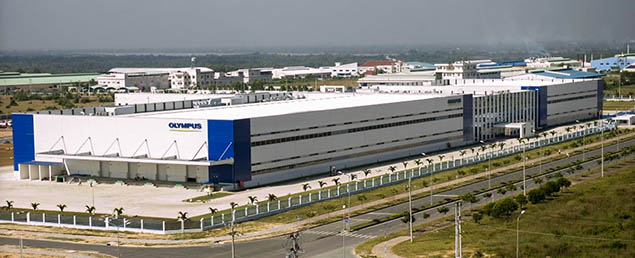
DE: Transitioning your main assembly operation to Vietnam was a significant cost, and I learned in an interview last year that the move was part of the reason it took so long to announce the E-M5 Mark III. Is that transition now complete? Can we expect to see more product announcements going forward, now that you’ve successfully made this transition?
MS: Yes, that move is finished now. And yes to the increased rate of product announcements. You’re right, we experienced some slowdown of new product development and manufacturing due to the factory transition, but now it's complete. Now that we’re catching up, we're accelerating the development and production of new products.
Coronavirus impact
[Ed. Note: As mentioned above, I visited Olympus in early March, before the Coronavirus had spread so widely across the world. At that point, the pandemic was still at an early stage, with only limited spread from its origin in China. Before publishing this transcript, I reached out to Olympus headquarters in Tokyo for an update. I've left my original questions and Sako-san's answers below, and added the updated information from Olympus Japan following.]
DE: This is a question I’m asking everyone this time: You’ve moved your main assembly plant to Vietnam, but how much of your supply chain is still in China, and what do you expect the impact to be from that? (It’s also going to have an obvious impact on Chinese consumer spending; how much of the total market does China represent for Olympus?)
MS: I can’t share any details, but even though our main factory is in Vietnam, some parts of our supply chain are still in China. So there might be some impact from the coronavirus, but we don’t see any significant impact at this moment. You can imagine, though, that it's an uncertain situation.
DE: In talking to other people, it seems that many of them have parts inventory to support production perhaps through the end of March, but are investigating to see what the impact will be after that. Is the situation similar with Olympus?
MS: There's some lead time of course, and some of the parts are in hand to cover future production for several months. It's of course different with different parts and different models, but hopefully the situation will get better.

Updated Virus Info
[Here are the followup questions I asked Olympus just prior to publishing this article and their official statements in reply. Given that no one can really predict what's going to happen with the virus at this point, it's unsurprising that the answers I received were a little vague. As you'll see, though, there was at least one interesting nugget of information in the information I got back.]
DE: It's been almost two months since I visited you in Shinjuku; what is the current impact of the coronavirus on Olympus' production capabilities?
Olympus: Olympus is continually monitoring the global developments around the COVID-19 pandemic and has set up a global task force to ensure business continuity. Although we do not foresee any short-term impact at this time, we are continually assessing our situation and will promptly inform customers about changes whenever appropriate. For the Imaging business, the supply has not been significantly affected.
DE: There are two parts to this, of course; the parts supply and the availability of workers in your own factory. How are things going in Vietnam? Is your factory there able to operate, or is there a general shutdown there now?
Olympus: Our factory in Vietnam has taken precautionary measures but continues operating regularly until further notice. At Olympus, the health and well-being of our employees is our top priority and we are doing everything we can to maintain supplies while also being vigilant about the risk.
DE: On the supply chain side, are some models OK and others being held up, or are there common parts that are preventing pretty much everything from being produced?
Olympus: Although the situation is different for each model, supply has slowed down in some areas, but so has demand. We try to maintain global supply chains and leverage demand through distribution control and inventory management. At this moment, we do not see huge shortages globally.
DE: To the extent that you are able to continue manufacturing cameras and lenses, are you able to ship the finished products to various global markets OK? At least one other company has told me that they're having difficulty getting products shipped to the US.
Olympus: While offices in China slowly start resuming regular operation, many offices in other Asian countries, Americas and in EMEA are working in shifts and/or from home where applicable. Manufacturing sites, field force and repair centers have taken precautionary measures but continue operating regularly until further notice.
DE: Is the coronavirus situation impacting your plans for product introductions?
Olympus: While monitoring and assessing the situation carefully, we will try to introduce our products at the appropriate time as possible.
DE: On the demand side, can you say anything about how much consumer demand has suffered as a result of the virus?
Olympus: Under the limited consumer purchasing activity in many counties, the demand for cameras has also been affected. The situation is constantly changing and we will watch the demand trend carefully.
DE: It's probably impossible to predict, but do you have any projections or thoughts on when the virus situation might ease, and when we might see the global consumer market start to revive?
Olympus: The development of the pandemic is out of our scope of influence. We are doing everything we can to maintain supplies while also being vigilant about the risk. At the same time we adapt our marketing and sales activities according to the global situation and try to stay connected with our customers.

Per-capital case density map as of April 30, 2020 by Raphaël Dunant, CC BY 4.0
Coronavirus bottom line
As you'd expect, Olympus can't project what course the virus will take as the situation continues to evolve around the world, and their carefully-worded responses reflect that. And they, of course, point out that the safety of their workers is their first priority. That said, there are a couple of interesting points here:
Their supply chain is largely intact
It sounds like they're able to get needed components in sufficient quantities to support their production. I was actually a little surprised to hear this.
Their main factory in Vietnam is operating
It's hard to imagine that there's no impact whatever on their workforce, but the bottom line is that their factory is continuing to operate "normally". Again, I was a bit surprised, but upon checking the official stats, Vietnam has a remarkably low number of identified COVID cases.
Shipping seems an open question
I've heard from at least one other company that it's difficult getting products shipped into the US from Asia. Normal air freight is significantly disrupted, because (a) commercial airlines aren't flying, and a surprising amount of international freight is carried in the bellies of commercial passenger flights, and (b) a lot of the remaining air cargo capacity is being used to ship critical medical supplies and personal protective equipment (PPE). Olympus didn't answer this question directly, but when I checked several online retailers, I didn't find any shortage of Olympus products.
Reduced consumer demand is pacing reductions in production capacity
This was perhaps the most interesting part of Olympus' answer: To whatever extent the Coronavirus might be impacting their production, consumers' reaction to the crisis has brought demand in line with supply. Bottom line, at least in the near term, you shouldn't find shortages of Olympus products at retail. (As noted above, I checked several major retailers before posting this story, and found full stock pretty much across the board for the latest E-M1, E-M5 and E-M10 models.) I wonder the extent to which this is the case for other camera manufacturers as well?
E-M1 Mark II status and E-M1 Mark III AF improvements
DE: Now that the E-M1 III has been announced, will the E-M1 II stay in the market alongside it, or will it go away once stock runs out?
MS: At this moment, the E-M1 II will be staying in the market together with the E-M1 III. It's a little different by region, in different markets depending on local strategies, but from a global perspective, both of these products are currently existing together.

DE: Ah, that's nice; the E-M1 II is a very capable camera, and now it'll be available at a lower price point.
MS: Yes, that's our goal. We really want to increase Olympus' customer base. For some customers, we, of course, want to recommend the new E-M1 III, but at the same time for other customers who may not need all the enhanced functions and features, the E-M1 II is still available in the market.
DE: The E-M1 III apparently has improved face and eye AF. What can you tell us about those improvements? Can you quantify the improvements relative to the E-M1 II? Will these improvements be available via firmware updates to either the E-M5 III or the E-M1 II?
MS: We reviewed and improved the algorithm completely; AF performance has been improved overall. By using human recognition and pattern recognition as well as face and eye priority AF, even when the face isn’t completely seen or can be difficult to recognize, the subject now can be tracked. [Ed. note: He seemed to be saying that the algorithm was almost a ground-up redesign; at the very least, it's apparently a significant revision.]
Compared to the E-M1 Mark II, we can recognize eyes at just 1/5 the size we previously could, and we can recognize faces at 2/3 of the previous face size. We did internal tests, with a person standing at different distances and found that was the level of improvement, so it's quite significant. It has human recognition and pattern recognition, so even if the eye disappears or is obscured somehow, the AF can still detect the face and eyes, because of some pattern recognition and human recognition. [Ed. note: Wow, recognizing eyes at just 1/5 the size that was previously possible is a major increase in capability. Faces at 2/3 the previous size is very nice too, but the eye recognition improvement is pretty dramatic.]
How does "Starry Sky" autofocus work?
DE: This is a kind of technical question, but we're very interested in the “Starry Sky AF” mode in the new E-M1 Mark III. How does Starry Sky AF work? When our senior editor William Brawley attended the launch event for the E-M1 III, it sounded like Starry Sky AF wasn’t conventional phase-detect AF; maybe it's some hybrid between phase-detect and contrast-detect(?) Can you describe anything about how it works?
[Ed. note: For readers, Starry Sky AF is just what it sounds like, a special AF mode for focusing on starry skies, which is often difficult for cameras. With Starry Sky AF enabled, you put an AF box over a star and start AF with the rear button. The camera works for a bit and then the AF box goes green, at which point you can use the shutter button to grab the shot. There are two modes, speed priority, which seems most suited to handheld shooting and Accuracy Priority, which seems to be meant for tripod use.]
MS: I can try to! <laughs> The brightness of stars is very low, so that’s why it's hard to focus on them. It's usually difficult to detect them with normal contrast AF. [Ed. Note: Phase-detect AF generally needs even more light than contrast-detect, and many cameras, in fact, have a hard time focusing on a starry sky with no other subjects in view.] Our Starry Sky AF utilizes several defocused images, and by using estimated values from those, the camera finds the image that has the highest brightness.
DE: Ah! So to make sure I understand, the camera goes through a range of focus settings, and analyzes the images to see which one has the highest pixel brightness? It looks at a range of defocused images, and kind of picks the middle?
MS: Right, that must be the brightest one. But how to detect which one is the brightest is a big technical challenge, and that’s one of the secrets of our development.
DE: Wow, that's very interesting, it's a completely different approach to how to focus on a subject than I've seen before.
MS: Yes, it's a completely different approach.
DE: And it works too, because it's a static image. It's not like you have to track something moving, so it has a little time to figure out where the best focus is. (I find it especially interesting that it uses a series of defocused images to help find the best focus point.)
MS: I can tell you a little bit more about it, but don’t ask me any more questions, because I don't think I can answer! <laughs> So for example, here are some of items we check to determine which image is the best one; it’s a combination of several different criteria:
- Maximum brightness value
- Number of pixels above the threshold
- Pixel integration value above the threshold
- Average pixel luminance value above the threshold <laughs at the technical obscurity, along with others in the room>
DE: That's OK, this is all making sense, actually! Wow, this is very interesting, it's looking at the brightness and how many pixels are above a threshold brightness, so if it's out of focus, you'd have more pixels above the threshold around a star.
MS: Hmm, hmm [yes]
DE: And then integration above a threshold, integration sounds like it's accumulating and integrating charge, maybe. [Ed. Note: On reflection, I don't think Sako-san was talking about integration over time, but rather integration of the brightness over a local area.] Hmm, and then average luminance above a threshold. That sounds like another way to quantify how much in- or out-of-focus a star is in each defocused image. Thanks for that! Or thanks to the engineers or whoever shared that information!
MS: <laughs> I'm just delivering the message!
What about AI-based autofocus modes?
[Ed. Note: One of the most striking capabilities of the Olympus E-M1X is what Olympus calls "Intelligent Subject Detection AF". The camera uses deep learning algorithms to detect very specific subject types. Tapping the power of its dual quad-core TruePic VIII image processors, it can recognize a range of subjects in real-time. Subject types include motor vehicles (Formula cars, rally cars and motorcycles), aviation (airplanes and helicopters) and railways (bullet trains, normal trains and steam locomotives), with pinpoint AF accuracy in each case. For example, the motor vehicles mode will put the AF point right on the driver's helmet, or if it can't see a car driver's helmet, it will focus on the front quarter-panel of the car. Aviation mode puts the AF point on the cockpit, and railway mode focuses on the conductor/engineer's seat. So-called deep learning is a common approach in the field of Artificial Intelligence, so I refer to these as "AI AF" modes. You can read more about how well it works in real life in our Olympus E-M1X field test review.]
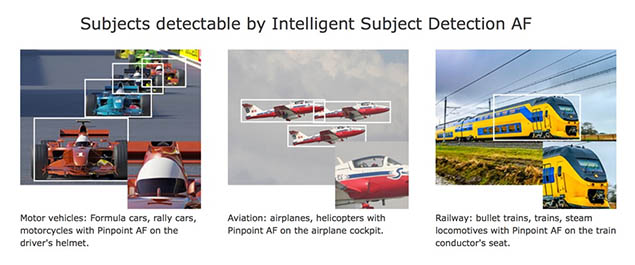
DE: So let's talk about AI AF, or Intelligent Subject Detection AF. I talked with the engineers at the E-M1X's introduction, and they said it might be possible to, you know, swap in different libraries for different types of subjects. They said that there isn't room in memory to add more subject types now, but that it might be possible in the future to swap out an existing subject type for another one. Are you, in fact, developing additional subject libraries for the E-M1X, or possibly other cameras?
MS: We can't share with you any details now, but we are in fact are currently studying what kinds of other subjects should be developed. We've received some good feedback and also some requests from the market, so we're considering how to evolve this.
DE: So you're evaluating different potential subjects. I imagine the algorithm people are working hard; it takes tens of thousands of images to "train" a system for object recognition like this.
MS: Yes, we're very interested in the evolution of this area.
DE: Yeah, that's such a unique capability, and especially things like ... when we were at the launch event in Daytona, it was raining so they didn't get to race, but even when they were just doing fast laps, it was so amazing to me the way the camera could find the driver in the car and put the AF point right on his helmet. Or put it on the front quarter-panel if the driver wasn't in view. It was very reliable.
DE: The E-M1X required two quad-core processors to handle the very sophisticated AI algorithms for these focus modes. When I interviewed the engineers at the time, they said that they chose to use general-purpose processors rather than ones made specifically to handle deep learning algorithms, because it was too early to lock-in their algorithm designs on a specific hardware architecture. Have things evolved to the point yet that you may be able to implement some AI processing in dedicated hardware?
MS: First of all, we’re always trying to develop better algorithms, with better engines or processors. As of this time, we haven't been able to implement Intelligent Subject Detection AF on just one processor; it still needs two processing chips, but we're working to be able to do it with one.
DE: I wasn't thinking so much of it being just a single processor; I was more wondering whether they now had hardware that was specific for AI (deep learning) processing. It sounds like the answer to that is still no, though.
MS: Yes, but there are still some new processor developments, however. The new E-M1 Mark III has a new TruePic IX processor, and it can realize some of the functions that could only be achieved before with dual TruePic VIII chips in the E-M1X. For example things like LiveND and some other features could only be done with two processors before, but can now be done on one processor because of the new TruePic IX engine. So our processing is continuing to get better and better.
DE: We were a little disappointed not to see some of the E-M1X AI AF options in the E-M1 III. How long do you think it will be before you're able to bring that E-M1X technology to other cameras?
MS: We ... <slight pause> ... can't say how long of course <both laugh>, but the R&D team is trying to accomplish that; that's definitely one of the items they're trying to achieve.
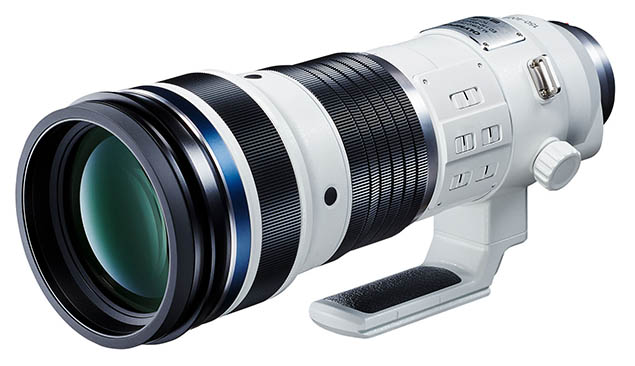
What's up with the 150-400mm?
DE: Switching to lenses for a bit, we’ve been hoping to see the 150-400mm f/4.5 Pro lens announced soon, and yet the development announcement is now more than a year old. Can you give us any indication of when we might actually see the lens coming to market? (I’d say that this question was to appease readers, but honestly, I'm actually asking more for ourselves: We’re really eager to see that lens!)
MS: Um... <awkward pause>
RDE: Of course you can never say anything specific... <both laugh>
MS: First of all, the development is really moving forward and progressing. We’re still aiming to launch this product within 2020; we don’t see any major issues, so you can expect to see it coming sometime this year.
DE: So you don't see any obstacles, but can’t comment on exactly when we'll see it...
MS: We wanted to announce its development at a pretty early phase, because we knew this lens would have a huge impact for some photographers, and it's also a very meaningful announcement to call attention to our system. At the time, full-frame mirrorless cameras were being launched by many companies, but Olympus was focusing on different things. I think one of the interviews you had with Aki in the US; even now I remember the headline of the article: not no, heck no! <laughs> We really wanted to show our direction and also our uniqueness and the value that we can provide to the market. We really think it's not good for the market to see all the new products being only full-frame; we don't think that's healthy for the industry. We want to keep providing very unique products; products that are very good for specific types of customers. This 150-400 lens could definitely be a very impactful announcement, especially for some customers, and also emphasize the uniqueness of our system. So we're very excited about this product.
DE: Yeah, a constant-aperture lens with an equivalent focal length of 300-800mm would be extremely difficult to make for full-frame. Or if you could make one at all, it would be so big and heavy that you'd need a pack-animal to carry it.
MS: Yes, and with a 1.25x teleconverter besides.
DE: Oh, that's right, I had forgotten that part. So the actual focal length range is 300-1000mm equivalent! Wow.
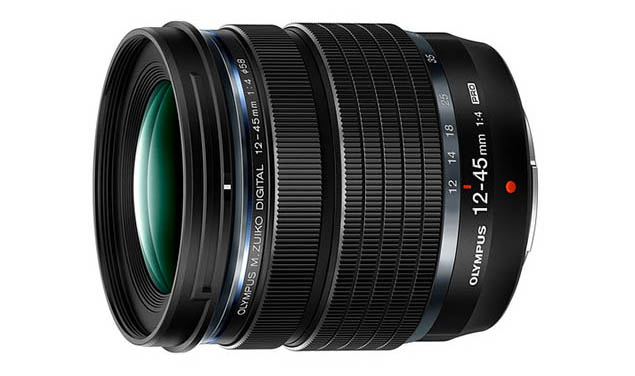
We love the new 12-45mm, does it mark the beginning of a trend?
DE: Also on the topic of lenses, we love the new 12-45mm f/4 PRO lens(!) It’s so compact, and we always like seeing the PRO image quality and weather-resistance appear in a new lens. Two questions related to it: First, does this perhaps indicate a new direction for your PRO lens line? It’s relatively affordable; I think it is actually the least-expensive PRO lens to date. Do you plan more smaller-aperture, more-affordable PRO lens models going forward?
MS: Yes. Actually, we received many requests from customers, even high-end users, asking us to launch PRO lens quality but in more compact and lightweight lenses, and we're trying to answer such requests. So we’ll continue developing such lenses: Compact size but still PRO quality.
DE: Although it’s a PRO lens and so perhaps aimed more at the higher-end market, this seems like an absolutely perfect match for the very compact E-M5 III body. Are there any plans to sell a kit, with it and the E-M5 III bundled together?
MS: Yes. That’s a plan. It’s still under consideration and study, but we believe it's a very good match with the E-M5 III. The actual launch of the kit might be different by region, though, based on local sales strategies. But definitely the 12-45mm f/4 and the E-M5 III are a great match.
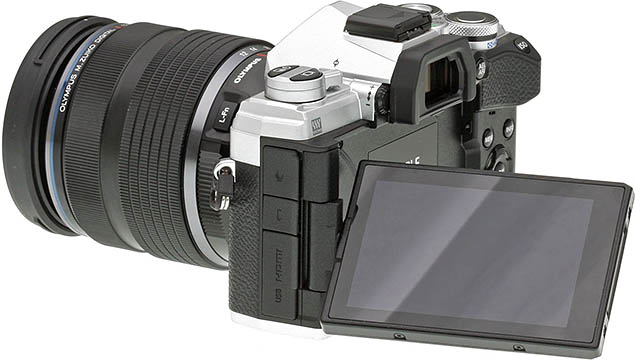
How is the E-M5 III doing?
DE: Speaking of the E-M5 III, I personally like it a lot. How is it being received in the market?
MS: I think it’s pretty good, because the features incorporated in it are really very high-end. So for those looking for higher-end features and specs but who still want a compact body, those are really the people it’s intended for and they seem to love it. We launched it last November or so, and sales are doing pretty good.
DE: Do you know or can you say if the sales are matching your target for it?
MS: They’re almost perfectly on track with our target. It depends on the particular market. Some markets are doing very well, some are slower, depending on marketing or price competition from other brands, but generally speaking, the E-M5 III is doing well and performing as we hoped.
Now that we’ve launched the E-M1 III, and like I said the E-M1 II is also existing in the market, I think there are some new options available to our customers. Some customers may wonder "which one I should pick?" When it comes to customers buying Olympus cameras, we're always happy, but of course, we need to clarify the plan now and our strategy, so a customer can pick the best OM-D camera for him or her. What we really want to communicate to the customer and the market is the overall value of our system. So we really want to have a clear message about our core values. That is: Compact and lightweight, very powerful image stabilization, and also very good lenses and optical technologies. So those things are our core messages and our core values. Now we have the E-M5 Mark III, the E-M1 Mark III, and the E-M1X; which OM-D is best for your preference? That's the marketing message that we are working on.
We've seen some price drops; is that a general direction for the platform overall?
DE: What’s your general direction for the platform overall? We’ve noticed that you’ve generally moved prices lower. This makes sense as you’ve recovered some of your engineering expenses as products have matured. Would you say this a deliberate strategy, to leverage existing investments to reduce going-forward price points?
MS: Basically, we want to increase our customer base, so we want to offer a lot of opportunities for customers to buy our cameras and utilize our system. So that’s one priority, that's why the products need to be affordable. Not necessarily simply lowering the price; that's not one of our strategies. But what’s the right value of the camera and what's the right price for customers to buy each product? So we monitor the market price in each market and the market values [in each] and then set the price.
Also, from a business perspective, we want to sell more lenses to customers; that's one of the important goals. Selling more bodies will mean more customers to buy lenses and the business will be stable.
But I don’t know; my colleagues in the US may say no, because I know competitors are also offering some aggressive prices. I checked the holiday prices at B&H and others, and they are also aggressive. So sometimes we need to set a competitive price.
DE: Yeah, I think there was a lot of discounting over the holidays, and even now there's still a good bit happening, with instant rebates and the like.
MS: Seriously, we think the consumers are everything, so it’s a question of what’s the right price for the customer. We don’t deny that there are pricing wars and sometimes we have to drop the price because of competition, but [the question is] what's the fair price and what's the right price for customers; that's what we always keep in mind.
DE: I feel that Olympus has really class-leading technologies in some areas, like IS and weather sealing in particular, and the whole system is very compact and the lenses are high quality, so overall, it's a high-value system. But you have to kind of explain to people that that's what they're getting.
MS: <laughs> Yes, we want to tell our value. You know some customers feel that because of the Micro Four Thirds sensor, a smaller sensor, the price should be low. That's one perception, but we think we can provide different values. From our perspective, what constitutes “good image quality”, that definition might be different by customer. We believe we can provide good image quality for certain customers who are not necessarily looking for a larger sensor or high megapixels. That's one part [of the equation]. But we really want to stick to our unique value to the customers and to the market; that's a very consistent point of our development philosophy.
Will we ever see a BSI (backside-illuminated) sensor in an Olympus camera?
DE: This is a bit deeper technology question about the sensors: The smaller sensor has an impact on high-ISO noise. But I've noticed that the Micro Four Thirds sensors all use N-MOS based frontside-illuminated technology. I realize that you have to work with the sensor manufacturers to get the sensors you need, but can we expect to see backside-illuminated (BSI) technology in Olympus cameras in the foreseeable future?
MS: Basically, we select a sensor in order to achieve our overall product development goals. At this moment, that leads us to choose front-side illuminated MOS sensors. That doesn’t mean that we’ll never select backside-illuminated in the future; that's an option in the future depending on our strategies and goals, of course. But at this moment, N-MOS is our choice for the sensor.
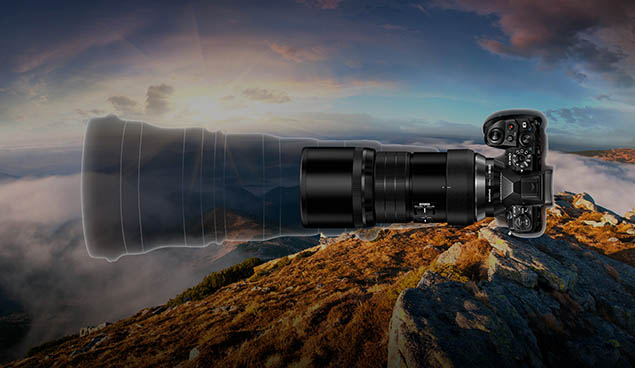
How can Olympus better get their message out?
DE: We were just talking about this: Olympus has a number advantages and features that we just discussed, but even as reviewers, we feel that people, in general, don't seem to think of those things immediately when they think of Olympus. So how do you plan to communicate that or address that lack of awareness; do you see other ways you could create awareness of your unique value proposition?
MS: We will continue communicating our system-wide uniqueness, which is once again, compact and lightweight, and also powerful IS. Also great lenses and optical technologies. [Ed. Note: Also weather sealing; Olympus does extremely well in that category, see my video on the topic.] So we want to continue telling that message to the market, prioritizing the story about the system advantages, rather than just single-product promotions. We want many people to understand what is the Olympus value, what is the uniqueness of the Olympus system. At the same time we're planning to bring this kind of message more to specific customers, specific target audiences.
For instance, now we’re studying which genres of photography can be best supported by our system. For example, you can imagine that our system would be very good for bird photography. In fact, we’ve heard from many bird photographers that our system is really good for them, that they see clear benefits with Olympus products. Also some other fields like wildlife or the mountain photography segment, or something like field macrophotography. In those segments or types of photography, customers may be able to experience the clear benefit or clear advantage of Olympus products.
So on top of the overall communication of our core values or core advantages to everybody, we also want to shift some of our resources and invest more to tell our message to those specific customers who can [most] clearly see the benefits of the Olympus system. That's something we're going to be doing this year.
DE: That makes sense; find and communicate to the people who have some kind of pain points with typical systems. For bird photographers, it's really perfect, because it's compact, you can get very long telephotos easily. (MS, interjecting: Handheld long teles, no tripod needed [because of the good image stabilization]) Yeah, I think the weather resistance is important for bird photographers too, because whatever weather the birds are out in, they'll be out too.
DE: I think that's the end of my questions today - and I see we're just coming up on 5pm (the end of our meeting's time slot), so good timing! Thanks so much for taking the time to speak with me today!
MS: Thank you!
Summary
I felt I learned a lot from this interview and my follow-up questions about Coronavirus impacts. Particularly interesting points were:
- The coronavirus pandemic is having modest impact on Olympus' production ability, but demand has been down as well; the two more or less balance out (bottom line: continued good availability of Olympus products at retail)
- Olympus' move of production from China to their factory in Vietnam is now complete; we can expect an increased pace of new-product development and announcements as a result
- The E-M1 Mark II will remain in the market alongside the new E-M1 Mark III (but strategy will vary, depending on national and regional markets). This is good news, as the E-M1 II is a very capable, rugged and compact camera; a lower price point will offer great value, even while the E-M1 III provides much-improved AF in some areas
- The E-M1 III's eye-detect and face-detect AF is significantly improved over the E-M1 II's (by a factor of 5, in the case of eye-detect sensitivity)
- I learned how the E-M1 III's Starry Sky AF mode works; it's a completely different approach than any I've seen to date, and appears to work very well at the normally-difficult task of focusing on stars
- The sophisticated AI AF (Intelligent Subject Identification Autofocus) modes of the E-M1X still require two processor chips to execute. This means we won't be seeing them in lower-end products than the E-M1X any time soon
- That said, Olympus continues to advance their processor technology: The LiveND feature required both processors in the E-M1X, but the more advanced TruePic IX chip in the E-M1 Mark III can handle it on its own
- Development of the 150-400mm lens is progressing very well; we can expect to see it later this year
- The new 12-45mm f/4 PRO lens marks a new direction for Olympus' lens development; we can expect to see more compact, smaller-maximum-aperture PRO lenses in the future
- We'll generally be seeing a trend towards lower prices, particularly for older products for which Olympus has recovered their engineering costs. It's clear that Olympus isn't focused on competing on price, but they want to make it easier for photographers to get into their system
- Olympus is going to focus their messaging this year on the unique value proposition of the system as a whole, rather than features of individual products. Their combination of compact size, class-leading IS, excellent optics and superior weather sealing is unique in the industry. They're going to concentrate on photographers who can particularly benefit from these advantages
Overall, it was an interesting visit; I always enjoy quizzing manufacturers about the latest goings-on, whether in terms of technology or the market. What do you think? Leave your thoughts and questions in the comments below, and I'll respond to the extent that I'm able. (I'll try to keep an eye on the comments for the next week or so after publishing, to hopefully give timely responses.)

